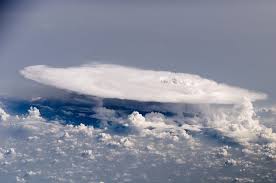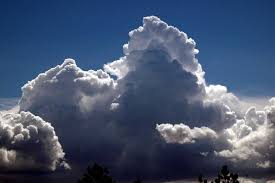The easiest assumption is to think of the atmosphere as anything above the ground or earth. This is because the unaided eye will not see far enough beyond the clouds to understand the various layers of the atmosphere.
But the atmosphere is a little more complex and plays a role of providing cover and actually controls the temperature of the activities on earth.
The atmosphere surrounds the earth and helps to moderate the extremes of heat and cold on it (Okebukola, 1997). On the basis of temperature, the atmosphere is composed of the troposphere stratosphere, mesosphere and the thermosphere.
These exist as layers around the earth. Their thickness around the earth varies from day to day and the distance from the pole.
1. Troposphere
The Troposphere is the lowest part of the atmosphere. It hosts humans and also accommodates the biosphere (plants and other organisms). It contains almost all (75 %) of the water vapour which forms the clouds and rain).
In the troposphere, the weather gets colder as the distance above the earth increases (the higher, the colder).
Read Also : On-site Municipal Wastewaters Treatment
The change in temperature is about 6.5 ᵒ C per kilometer but the daily change of temperature with height fluctuates. Air higher up is cooler than air lower down. Birds and airplanes use the troposphere.
2. Stratosphere
Immediately above the troposphere is the Stratosphere. It extends up to a height of 50 km. The temperature remains almost the same in the lower part of this layer up to the height of 20 km.
After this, the temperature increases slowly with increasing height. The presence of ozone gas in the upper zone of the Stratosphere leads to increases in temperature in the layer.
The fact that air blows horizontally makes the lower layer of this zone also ideal for flying of aircraft.
The upper limit of the stratosphere is known as Stratopause. It has a layer of ozone gas measured in Dobson Units.
3. Mesosphere
Above the Stratosphere is Mesosphere. It extends from the height of 50 km to 80 km. In this layer, the temperature starts decreasing with increasing altitude and reaches up to – 100 ᵒC at the height of 80 km.
Meteors or falling stars are found in this layer. The upper limit of the mesosphere is known as Mesopause.
4. Thermosphere
This layer is located above the Mesopause between 80 and 400 km. Abundant in this layer are electrically charged particles known as ions, hence, it is known as the ionosphere.

The layer of ions in this zone reflects radio waves from the earth back thus enabling radio broadcasting. Generally the temperature increases with height.
5. Exosphere
The Exosphere is the uppermost layer of the atmosphere. It is the lightest of the layers of the earth due to the near absence of gases.
Atmospheric Processes
As noticed in the description of the layers of the atmosphere, the atmospheric processes are:
1. Water evaporation in the troposphere. Evaporation is the loss of water in the liquid state to the gaseous state as a result of changes in temperature.
For example, evaporation is higher at the equator with high temperature when compared with that at the poles with lower temperature.
Similarly, when temperature of surface of streams, rivers, oceans, seas and lakes and from soils increases they lose water to the atmosphere by evaporation. When loss of water takes places from leaves, barks of trees, it is called transpiration.
2. Climate changes within and between the layers of the atmosphere. The emission of greenhouse gases into the air has caused climate changes such as temperature rise in the troposphere.
3. Radiation from sun and the concentration of ions in the thermosphere (ionosphere) contribute to climatic changes in the atmosphere.
4. Rainfall and clouding in the troposphere. The evaporation of water vapour from the surface of the earth saturates as clouds in the air. When the level of saturation becomes heavy, the air becomes cooler and the clouds become bigger and begin to precipitate.
5. Global warming within the stratosphere. This is a phenomena which lead to the sudden rise in the earth’s temperature occasioned by the absorption of infrared radiation emitted by the earth surface by certain gases in the atmosphere.
Read Also : On-site Municipal Wastewaters Treatment
Global warming is enhanced by industrialization, burning of fossil fuels in automobiles and generators, the excessive use of chemical fertilizers used in agriculture, exploitation of natural resources, deforestation, urbanization and development of cities etc.
Industrialization by the developed nations (Canada, U.S.A, U.K., Japan, Germany, France, Italy etc.) has resulted in greenhouse effect and depletion of ozone layer.
6. Geoscientific actions. The Lithosphere is connected with both the biosphere, hydrosphere and the troposphere. The interactions between these are interwoven.
For example, surface waters are evaporated and or lost from plants and trees by transpiration to form clouds in the troposphere which precipitate and again recharge the earth. Precipitation or rainfall may weaken chemical bonds and cause weathering and fracturing of rocks.

